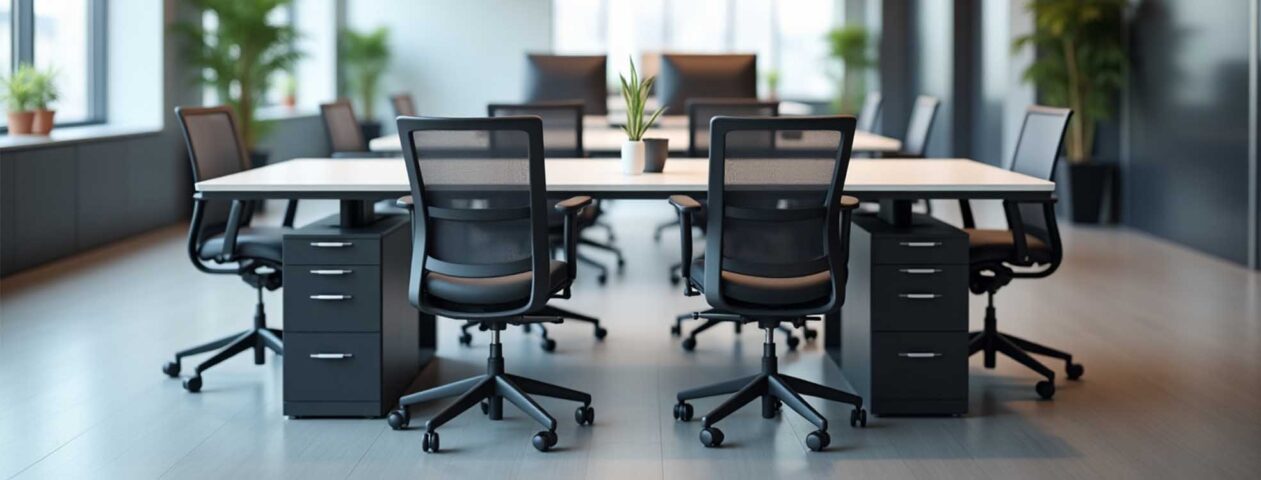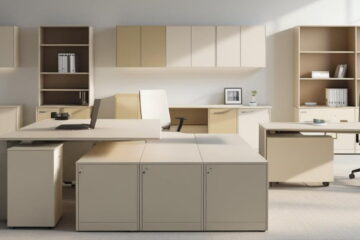In today’s dynamic working environment, the lines between physical comfort and productivity are frequently overlapping. This reason gave an importance to ergonomic office furniture that can’t be deniable. Ergonomics in office furniture design must be preferable because it just not a luxury but it impact on employee health, work performance and business productivity.
Understanding Ergonomics in Office Furniture Design
Ergonomic is a technology used to design the furniture for your workspace that keeps the employee fit & healthy. In office furniture design, ergonomic always focuses to ensure the comfort level of employee such as right body posture, smooth movement and reduce fatigue during long hour of sitting at your workplace.
Human-centric ergonomic design fulfills all the expectations of office individuals. The aim of ergonomics in office furniture design is to reduce physical strain and improve health of employee’s as well as boost business productivity.
Why Ergonomics Matters: Core Benefits
Enhance Employee Well-Being
- Ergonomic in office furniture designs are helpful for employees to get better posture that reduce pain or discomfort like backache, neck, and wrist pain.
- Office furniture with Ergonomic designs helps to reduces fatigue that can lead extra energy and focus throughout the workday.
- It also supports in employee mental health to reduce stress and provide a comfortable working environment.
Boost Productivity
- Ergonomic in office furniture designs offers comfortable and distraction free workspace to the employees so they can perform their work more efficiently and boost productivity.
- Studies show that ergonomic designs in office furniture always boost productivity as well as employee health.
Low Absent ratio and Health Costs
- Ergonomic designs in office furniture always offer better posture to work an employee’s. Which result in less work related injuries and physical strain and reduces healthcare costs and absent of employees.
- Investment in modular office furniture with ergonomic designs is just not for employee wellness but it also enhances business sustainability.
Key Elements of Ergonomic Office Furniture Design
Ergonomic Chairs
Ergonomic Chairs for Office with multiple features such as adjustable height, flexible armrests, mesh back lumbar support and synchro central mechanism enables healthy posture for different body sizes to encourage movement and reduce the risk of static position for long time.
As highlighted in How Ergonomic Chairs Positive Impact on Health and Boost Productivity at the Workplace, using ergonomic seating not only supports the natural body alignment but also minimizes physical strain, thereby enhancing focus, comfort, and overall productivity in the workplace.
Desks and Workstations
- Height Adjustable Desk (known as standing desk, sit and stand desk) allow employee to sit and stand between various positions that result to reduce strain as well as stress.
- Provides enough space to place monitors, keyboards, and other required accessories to ensure the items are within comfortable reach.
Accessories and Placement
- Use of screen stands which raise the screens to eye level and reduces eye and neck strain.
- Strategic arrangement of equipment reduces awkward stretching and repetitive movements.
Space Planning and Layout
- Office Workstations are arranged for easy movement and collaboration, with clear pathways and organized office storage solutions.
- Adaptable breakout and meeting areas foster both teamwork and focused work, essential for modern office dynamics.
As detailed in How To Plan and Organize Your Office Space with Modular Furniture, modular furniture plays a key role in creating flexible and efficient office environments. Modular workstations, height-adjustable desks, and ergonomic chairs allow you to quickly reconfigure spaces to meet evolving business needs while maintaining a balance between collaboration and individual focus.
Implementation Strategies
Ergonomic Assessment
Before choosing the right modular furniture for office, organizations benefit from assessing workforce needs, evaluating current pain points, and soliciting employee feedback.
Customization
Flexibility is key: Furniture should suit a wide range of physical requirements and job functions. For instance, adjustable arms and backrests ensure inclusivity for taller, shorter, or differently-abled workers.
Integration with Technology
Modern office equipment is often optimized for use alongside laptops, tablets, and dual-monitor setups. Ergonomic furniture must evolve to accommodate these trends, such as by integrating cable management and modular accessories.
Aesthetics and Functionality: Beyond Comfort
Contemporary ergonomic office furniture balances functionality, health benefits, and visual appeal. Designs now seamlessly integrate smart technology and stylish art elements, reflecting both cultural identity and employee preferences. This holistic approach not only boosts productivity but improves workplace morale and company image.
Real-World Impact and Business Value
Companies who are investing in ergonomically design modular office furniture in their office environments consistently reports:
- Their employees are very much satisfied with their job.
- Absent percentage is very low due to sickness, stress or injury.
- Increase in productivity as well as company reputation.
So modular office furniture with ergonomic designs always increased productivity, employee well-being and reduced liability related to occupational injuries.
The Future of Ergonomic Office Design
In Today’s office scenario, the ergonomic office furniture designs are high in demand due to its flexibility, adaptability, and health benefits. The Corporate offices, home offices and co-working spaces, all are now adapting remote and hybrid working models so they require ergonomic office furniture for better productivity and employee well-being.
As emphasized in Why Height Adjustable Tables Are the Future of Productive Workspaces, height adjustable tables play a crucial role in this transformation by promoting movement, reducing the risks of prolonged sitting, and offering customizable comfort. By enabling users to alternate effortlessly between sitting and standing, these tables not only improve physical health but also enhance focus and collaboration—making them an indispensable element in modern, dynamic work environments.
Conclusion
Ergonomics in office furniture design is fundamentally reshaping workspaces, with positive effects cascading from individual health and comfort to team productivity and organizational success. By prioritizing ergonomic principles—in choice of furniture, office layout, and company culture—businesses can unlock a thriving, sustainable, and future-ready work environment. Partnering with a trusted office furniture manufacturer ensures that these ergonomic solutions are designed with precision, durability, and employee well-being in mind.



